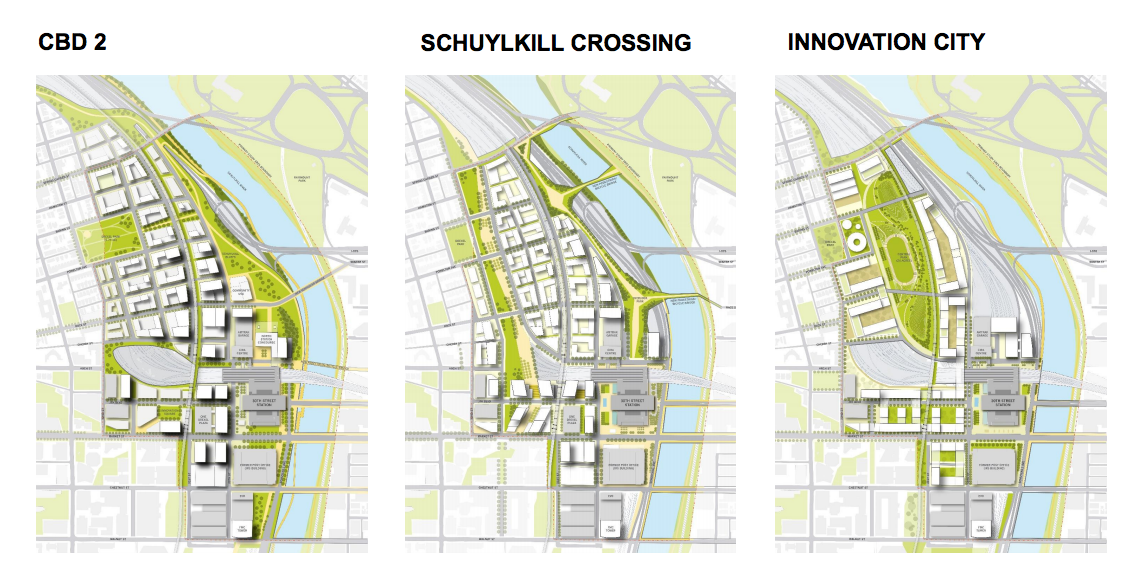30th Street Station District Plan to reveal 3 bold diagrams for capping rail yards; seeks public feedback

On Wednesday, the 17-member organization team led by Amtrak, Brandywine Realty Trust, Drexel University, PennDOT and SEPTA that is developing a comprehensive plan for the 30th Street Station District will unveil three diagrams to the public presenting differing ideas and concepts for the long-dreamt about area surrounding the train station.
PlanPhilly got a chance to preview the diagrams last week with Amtrak spokesman Craig Schulz and Natalie Shieh, Project Director for the 30th Street Station District Plan. Along with representatives from the rest of the team, Amtrak will host an open house at 30th Street Station Wednesday June 17, from 4:00 P.M to 7:00 P.M., and is looking for lots of public feedback.
Before I start spoiling the diagrams, a quick word on why I’m carefully using the term “diagram” and the purpose of Wednesday’s event:
The 30th Street Station District team has produced three diagrams offering a wide range of different elements that could ultimately find their way into a final plan for the district. As Inga Saffron wrote about the four diagrams for LOVE Park’s redesign, these aren’t designs or plans – which imply finality or the sense that the public should pick one favorite over the others – but rather diagrams offering a menu of different options and design elements for the public to weigh in on. Should the new District create a park overlooking the waterfront? Should the plan focus on building urban campuses ala the Navy Yard, or the kind of mixed-use development found today right across the Schuylkill? Should building a new pedestrian bridge be a priority?
If you participate in the open house, the idea isn’t to pick which of the three diagrams you like most, but to highlight the elements in each that are noteworthy for their merits, or lack thereof (knowing which ideas are bad is just as important as knowing which are good).
The diagrams are divided into three themes: “Central Business District 2” (CBD 2), a Center City-meets-University City Science Center type office district featuring a Schuylkill-fronting park above a decked-over I-76; “Schuylkill Crossing”, a more residential, mixed-use neighborhood emphasizing multi-modal transportation, and; “Innovation City”, an R&D campus matching Drexel’s “Innovation Neighborhood” that uses innovative building design to bridge rail yards centered around a centrally-located public space modeled after Chicago’s Millennium Park.
OUT OF SIGHT? NO ONE WILL MIND… RIGHT?
All three of the diagrams call for capping parts of the rail yards and highways to the north and west of 30th Street Stations, although the amount of coverage varies. As I noted when the planning process for the 30th Street Station District kicked off in January, building over the rail yards is a tremendously expensive proposition that can only be economically justified by relatively high property values (absent the sort of massive public investment Philadelphia hasn’t seen since the Centennial). And turning Mantua into one of Philadelphia’s pricier neighborhoods would be a necessary prerequisite to achieving those elevated property values.
That’s a tricky proposition wrought with uncomfortable implications for gentrification and the potential for displacing lower income residents. To the District Plan team’s credit, Shieh says they have been working with Councilwoman Jannie Blackwell, who represents the area, to reach out to area residents, notifying local community groups and posting flyers.
Unless the politiicians and planners can develop a sensible, realistic response to address the socio-economic ramifications of transforming Mantua from one of Philly’s poorest neighborhoods into one of its poshest over the next twenty five years, these plans risk engendering significant local opposition. So far, such a response to the area’s gentrification has been an afterthought.
The diagrams also feature proposals to expand the station itself, create new retail spaces, expanded entrances and more.
NO TUNNEL, BUT STILL LOTS TO LOVE
Notably, none of the three diagrams includes plans to reopen the underground tunnel connecting 30th Street Station and SEPTA’s Market-Frankford Line, despite a fairly loud call for it. Closed decades ago and now covered by Bridgewater’s Pub, the tunnel once allowed Amtrak and Regional Rail riders to walk to the MFL station without braving the elements or the sometimes-aggressive traffic on 30th Street. All of the diagrams address that later concern by placing a head house with access to the MFL station on the Eastern side of 30th Street, obviating the need to cross the street.
Perhaps what’s most notable about all of these proposals is their scale. In a city long accustomed to settling for the cheaper, less-transformative option, the partnership behind the 30th Street District Plan is daring to dream big. Really big. The most conservative vision, the Innovation City, still aims to create a massive new neighborhood in the heart of Philadelphia.
This sort of vision has come and gone in the past, proffered by a daydreaming architect or overly ambitious design students. Why should long-jaded Philadelphia dreamers treat this planning process any differently?
It comes back to that 17-member team that bridges federal, state and local government plus the for- and non-profit sectors, including Drexel University. Drexel’s President, John Fry, transformed University City as Penn’s Executive President, and has plans for Drexel to make that impressive act seem like little more than an opening band before the headliner take the stage.
“We are daring to be great,” said Amtrak’s Shieh. “Absolutely, let’s do something great here. Let’s not let the pragmatism… shy us away from that aspiration. But, have it inform [us] in a really smart way.”
Just what that aspiration ends up looking like depends on part on you. If you can’t make the Open House Wednesday, you can still offer some feedback by emailing info@phillydistrict30.com.
WHYY is your source for fact-based, in-depth journalism and information. As a nonprofit organization, we rely on financial support from readers like you. Please give today.






